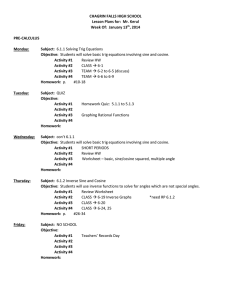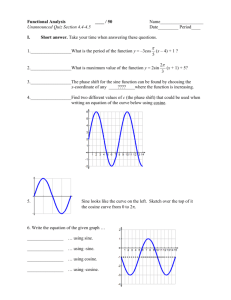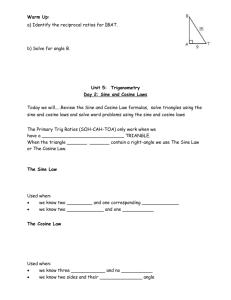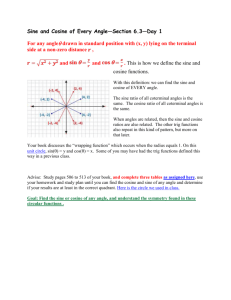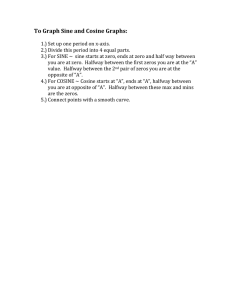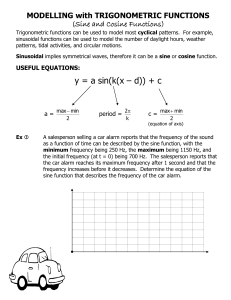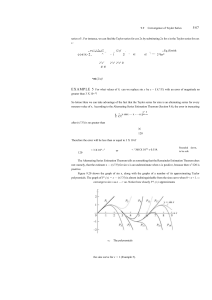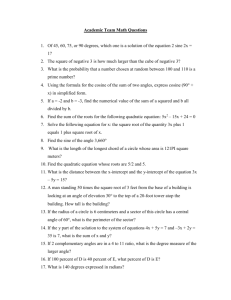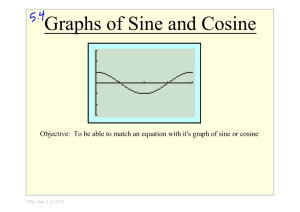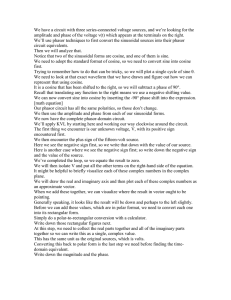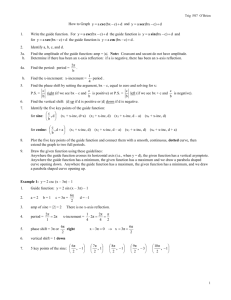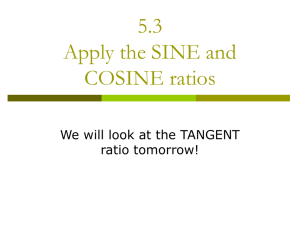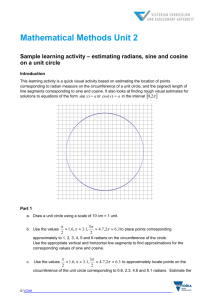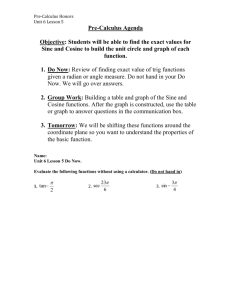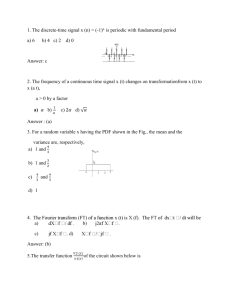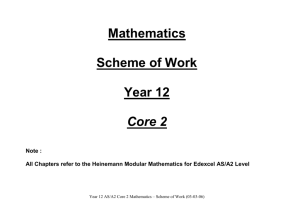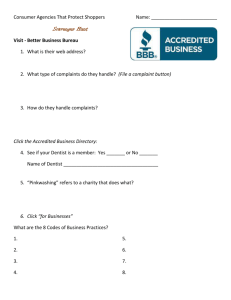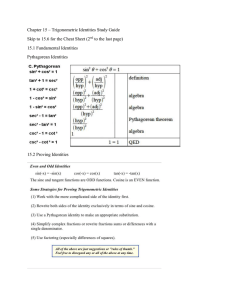Derivation of Taylor Series Approximation Description: The Taylor
advertisement
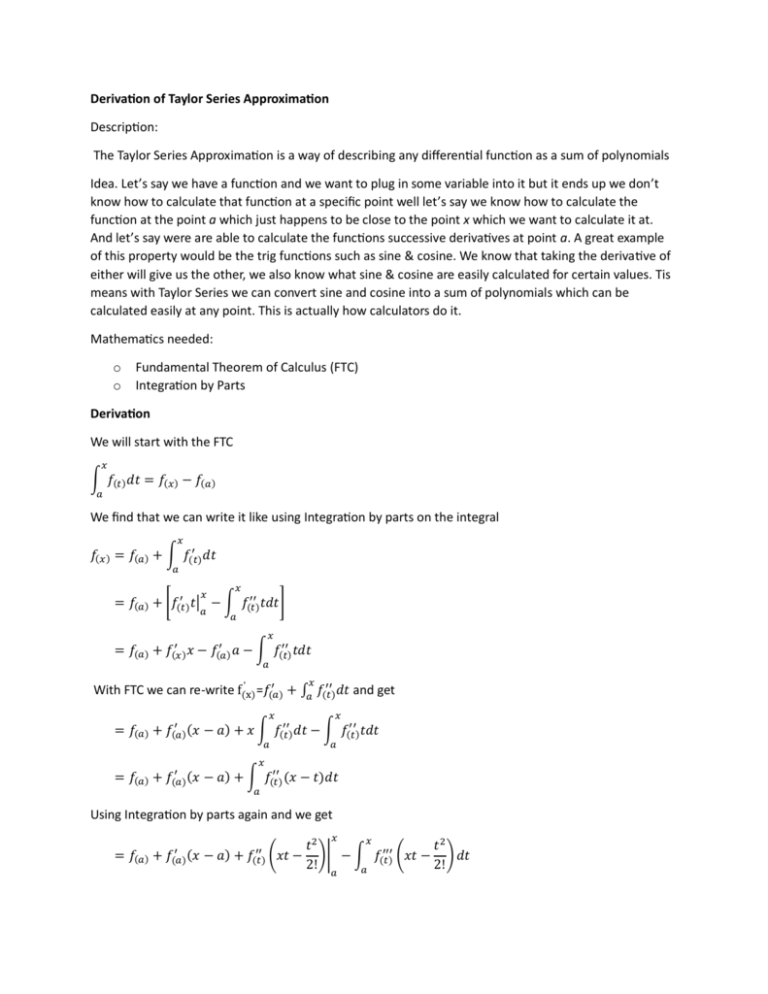
Derivation of Taylor Series Approximation Description: The Taylor Series Approximation is a way of describing any differential function as a sum of polynomials Idea. Let’s say we have a function and we want to plug in some variable into it but it ends up we don’t know how to calculate that function at a specific point well let’s say we know how to calculate the function at the point a which just happens to be close to the point x which we want to calculate it at. And let’s say were are able to calculate the functions successive derivatives at point a. A great example of this property would be the trig functions such as sine & cosine. We know that taking the derivative of either will give us the other, we also know what sine & cosine are easily calculated for certain values. Tis means with Taylor Series we can convert sine and cosine into a sum of polynomials which can be calculated easily at any point. This is actually how calculators do it. Mathematics needed: o o Fundamental Theorem of Calculus (FTC) Integration by Parts Derivation We will start with the FTC 𝑥 ∫ 𝑓(𝑡) 𝑑𝑡 = 𝑓(𝑥) − 𝑓(𝑎) 𝑎 We find that we can write it like using Integration by parts on the integral 𝑥 ′ 𝑓(𝑥) = 𝑓(𝑎) + ∫ 𝑓(𝑡) 𝑑𝑡 𝑎 = 𝑥 ′ 𝑓(𝑎) + [𝑓(𝑡) 𝑡| 𝑎 𝑥 ′′ − ∫ 𝑓(𝑡) 𝑡𝑑𝑡 ] 𝑎 𝑥 ′ ′ ′′ = 𝑓(𝑎) + 𝑓(𝑥) 𝑥 − 𝑓(𝑎) 𝑎 − ∫ 𝑓(𝑡) 𝑡𝑑𝑡 𝑎 𝑥 ' ′ ′′ With FTC we can re-write f(x) =𝑓(𝑎) + ∫𝑎 𝑓(𝑡) 𝑑𝑡 and get 𝑥 𝑥 ′ ′′ ′′ (𝑥 − 𝑎) + 𝑥 ∫ 𝑓(𝑡) = 𝑓(𝑎) + 𝑓(𝑎) 𝑑𝑡 − ∫ 𝑓(𝑡) 𝑡𝑑𝑡 𝑎 𝑎 𝑥 ′ (𝑥 ′′ = 𝑓(𝑎) + 𝑓(𝑎) − 𝑎) + ∫ 𝑓(𝑡) (𝑥 − 𝑡)𝑑𝑡 𝑎 Using Integration by parts again and we get 𝑥 = ′ (𝑥 𝑓(𝑎) + 𝑓(𝑎) − 𝑎) + ′′ 𝑓(𝑡) 𝑥 𝑡2 𝑡2 ′′′ (𝑥𝑡 − )| − ∫ 𝑓(𝑡) (𝑥𝑡 − ) 𝑑𝑡 2! 𝑎 2! 𝑎 ′ (𝑥 = 𝑓(𝑎) + 𝑓(𝑎) − 𝑎) + 𝑥 𝑥 2 ′′ 𝑎 2 ′′ 𝑡2 ′′ ′′′ 𝑓(𝑥) − 𝑎𝑥𝑓(𝑎) + 𝑓(𝑎) − ∫ 𝑓(𝑡) (𝑥𝑡 − ) 𝑑𝑡 2 2 2! 𝑎 We will once again use the same strategy to get rid of the function of x and we get = 𝑓(𝑎) + ′ (𝑥 𝑓(𝑎) 𝑥 𝑥 2 ′′ 𝑎 2 ′′ 𝑥 2 𝑥 ′′′ 𝑡2 ′′ ′′′ − 𝑎) + 𝑓(𝑎) − 𝑎𝑥𝑓(𝑎) + 𝑓(𝑎) − ∫ 𝑓(𝑡) 𝑑𝑡 − ∫ 𝑓(𝑡) (𝑥𝑡 − ) 𝑑𝑡 2 2 2 𝑎 2! 𝑎 ′ (𝑥 = 𝑓(𝑎) + 𝑓(𝑎) − 𝑎) + 𝑥 2 𝑥 2 ′′ 𝑎 2 ′′ 𝑥2 ′′ ′′′ 𝑡 𝑓(𝑎) 𝑎𝑥𝑓(𝑎) + 𝑓(𝑎) + ∫ 𝑓(𝑡) ( − 𝑥𝑡 − ) 𝑑𝑡 2 2 2! 2! 𝑎 ′ (𝑥 = 𝑓(𝑎) + 𝑓(𝑎) − 𝑎) + 𝑥 2 1 ′′ 𝑥2 ′′′ 𝑡 𝑓(𝑎) (𝑥 − 𝑎)2 + ∫ 𝑓(𝑡) ( − 𝑥𝑡 − ) 𝑑𝑡 2! 2! 2! 𝑎 From here we would do integration by parts again and we would find that there is a pattern to this process. In the end we are able express it as an infinite sum. ∞ 𝑓(𝑥) 𝑖 (𝑥 𝑓(𝑎) − 𝑎)𝑖 =∑ 𝑖! 𝑖=0
